 |
 |
|||||||||||||||||||||
|
||||||||||||||||||||||
AZFO FIELD EXPEDITION
Muleshoe Ranch Preserve
February 13-15, 2015
By Eric Hough
Grassland and riparian vegetation types are some of the most endangered habitats in the world, particularly in Arizona. Sanctuaries such as the Muleshoe Ranch Preserve in southeastern Arizona provide protection and active habitat restoration that help maintain and recover these ecosystems, and the wildlife populations that reside within them. The Muleshoe Ranch Preserve Cooperative Management Area covers 49,120 acres of public and private lands managed by The Nature Conservancy, U.S. Bureau of Land Management, and U.S. Forest Service. Situated in northwestern Cochise County east of the San Pedro River, south of the Galiuro Mountains, and west of the Winchester Mountains and Sulphur Springs Valley, the preserve encompasses seven springs with associated cottonwood-sycamore-ash dominated riparian areas, grasslands, upland desert-scrub, and oak woodlands across rolling hills. Since 1992, livestock grazing has been removed from the preserve to help the riparian areas and grasslands recover, and five prescribed burns since 1998 have treated almost 25,000 acres to help restore grassland habitat. While the distribution of breeding bird species of this preserve is more well-known, very few birders visit this preserve during winter outside of occasional January field trips during the annual Wings Over Willcox festival. Prior to this expedition, bar graphs on eBird (ebird.org) revealed data gaps for most of the late fall and winter, particularly for the month of February. This expedition focused on exploring the species richness and density of resident and wintering bird species, especially within the preserve’s restored grasslands and riparian areas. Results of the bird surveys are summarized in Table 1 of the Appendix.
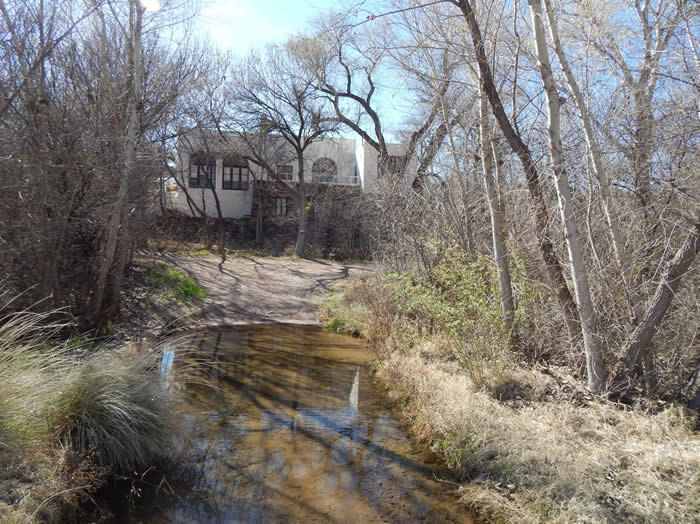 |
Figure 1. Hot Springs Wash at the Muleshoe Ranch Preserve headquarters (© Eric Hough).
|
FRIDAY, FEBRUARY 13, 2015
Seven participants from as far away as Flagstaff, Heber, Phoenix, Tucson, and Cascabel met up over the weekend to survey Muleshoe Ranch Preserve. Driving towards the preserve from Willcox via Three Links Rd. and Muleshoe Ranch Rd. on Friday morning, the grasslands were alive with birds including a Golden Eagle and large flocks of Horned Larks, Chestnut-collared Longspurs, Lark Buntings, and sparrow flocks. I was also delighted to see a herd of 14 pronghorn moving through a large grassy swale among the rolling hills. Besides the grasslands and wildlife, the drive towards the preserve also has fantastic views. Along this drive, one can spot most of the famed “sky island” mountain ranges of southeastern Arizona, including the Pinaleño, Winchester, Dos Cabezas, Chiricahua, Dragoon, Mule, Huachuca, Whetstone, Santa Rita, Santa Catalina, Rincon, and Galiuro Mountains. While some of the grassland habitat is still intact, much of the land has been grazed and current wind and solar energy developments are converting more of this habitat and fragmenting the land with more roads, making the existence of places like the Muleshoe Ranch Preserve all the more crucial for protecting the grassland and riparian habitat that wildlife populations of the region depend upon.
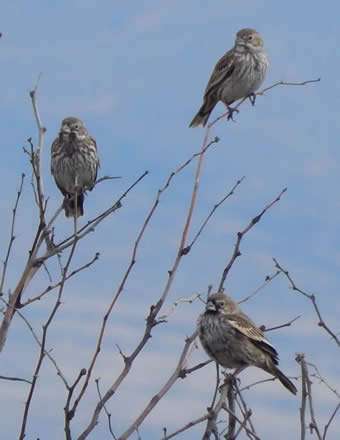 |
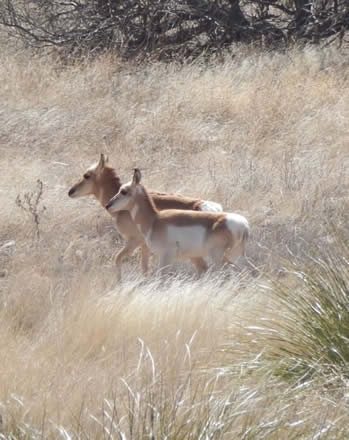 |
|
| Figure 2. a) Lark Buntings (© Eric Hough) and | b) Pronghorns (© Eric Hough). |
Since camping is not allowed on the preserve, we found a primitive campsite a few miles south of the preserve on state lands along a mesquite-lined wash. After setting up our tents and enjoying a Greater Roadrunner, Ferruginous Hawk, and Mountain Bluebird that came by our camp, Craig Anderson and I went up to the Muleshoe Ranch Preserve headquarters to start looking for birds along the riparian area of Hot Springs Wash. As soon as we entered the velvet mesquite-hackberry bosque near the headquarters, we were astounded to see dozens of Cedar Waxwings and American Robins flying back and forth from the fruit-laden hackberry trees to drink along the seepwillow (Baccharis salicifolia)–lined creek. When the hackberry trees have a good crop year such as this winter, this preserve definitely appears to be an important wintering site for frugivores. As we continued down the wash into the stands of Fremont cottonwood (Populus fremontii), velvet ash (Fraxinus velutina), mesquite (Prosopis sp.), and netleaf hackberry (Celtis reticulata), we also detected a couple of Black Phoebes, a Red-naped Sapsucker, a Northern Beardless-Tyrannulet, a Dusky Flycatcher, a Brown Creeper, a few Spotted Towhees, and several Dark-eyed Juncos (‘Pink-sided’, ‘Oregon’, and ‘Gray-headed’ forms) and Northern Cardinals. As it neared dusk, a few Hermit Thrushes made their presence known with their low “chup” calls. Back at camp, we met up with Anne Pellegrini, Sue Kozacek, and Jean Siesener to go over survey plans over dinner while we listened to some nearby Great Horned Owls in the brisk twilight.
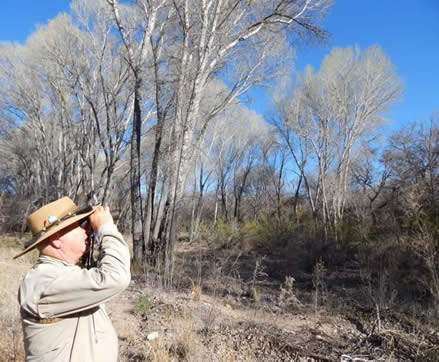 |
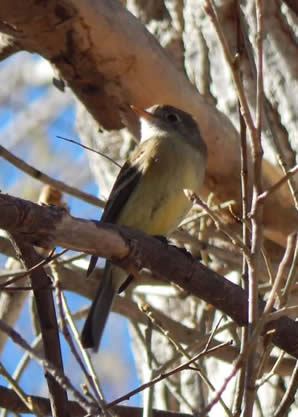 |
|
Figure 3. a) Craig Anderson birding along Hot Springs Wash and (© Eric Hough) |
b) Dusky Flycatcher (© Eric Hough). |
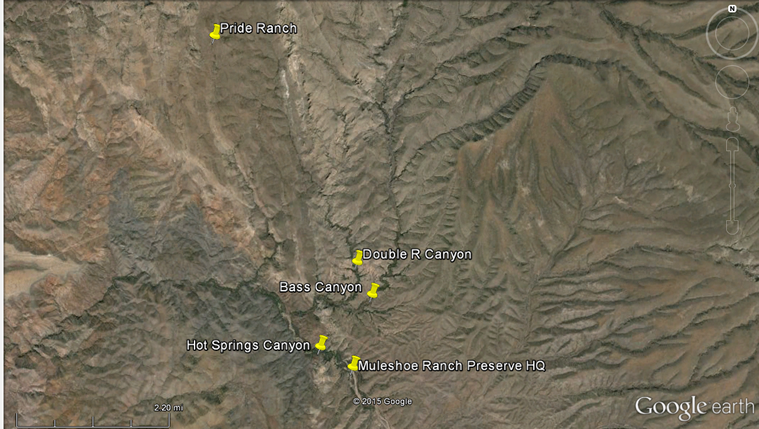 |
| Figure 4. Map of Muleshoe Ranch Preserve (© Google Earth 2015). |
SATURDAY, FEBRUARY 14, 2015
Grasslands of the Pride Ranch area:
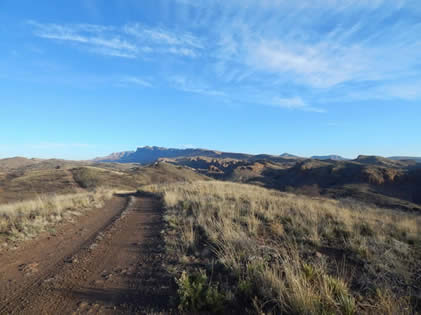 |
Figure 5. View from Jackson Cabin Rd. looking north towards the Galiuro Mountains (© Eric Hough). |
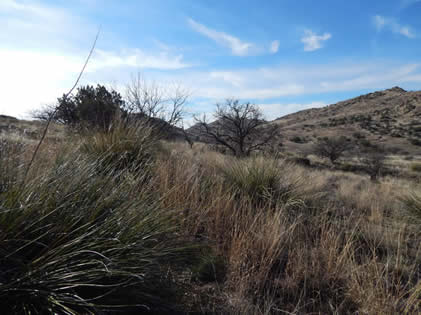 |
| Figure 6. Recovering grassland habitat around Pride Ranch (© Eric Hough). |
At dawn we met up with Bob Evans at the preserve’s day-use parking lot and headed north on the rugged Jackson Cabin Rd. to some recovering grasslands near Pride Ranch, six miles north of the headquarters (a 4WD and high clearance vehicle is a must for this road!). Heading north from the headquarters, the road crosses through the riparian area of Bass Canyon before cresting some hills with truly scenic vistas of more rolling hills, granite outcrops, and distant high cliffs along the southern end of the Galiuro Mountains. We split up into two teams to cover the grassland habitat on either side of about a one-mile stretch of road near the ruins of the old Pride Ranch. The grassland here is still recovering, with a mosaic pattern of differing patch densities and heights. Grass species here included sideoats grama (Bouteloua curtipendula), cane beardgrass (Bothriochloa barbinodis), Arizona cottontop (Digitaria californica), and bluestem (Schizachyrium or Andropogon sp.), mixed with the yucca-relative, beargrass (Nolina microcarpa).
Despite blustery morning conditions, we still found large flocks of wintering sparrows and resident bird species. Chipping Sparrows were by far the most numerous, with over 200 in the area we covered. Mixed in with these flocks or flushed from the grass singly, we also found Brewer’s, Vesper, Black-throated, Savannah, Grasshopper, Lincoln’s, and White-crowned Sparrows, and Dark-eyed Juncos. One team also reported four possible Rufous-winged and one possible Cassin’s Sparrow, although these were not confirmed. Up on the hill sides and rocky outcrops, we also heard singing Rock Wrens, Canyon Towhees, and Rufous-crowned Sparrows. In the adjacent drainages we also found Western Scrub-Jays, Hutton’s Vireos, Verdins, and Ruby-crowned Kinglets present. As the morning wore on, a Crissal Thrasher began singing away and a trio of Red-tailed Hawks provided an awesome aerial show while two apparently battled over a mate, one of the birds holding a jackrabbit.
Riparian areas of Hot Springs, Bass, and Double R Canyons:
After grabbing lunch back at our base camp and meeting up with Bonnie Swarbrick, we split into three groups to cover stretches of Hot Springs Canyon, Bass Canyon, and Double R Canyon just north of the headquarters. Starting from the headquarters, Craig, Sue, and Jean checked out the mesquite-hackberry bosque and cottonwood-ash groves along Hot Springs Wash, where they found similar high numbers of Cedar Waxwings and American Robins as had been found the day before, plus a couple of White-breasted Nuthatches and the continuing Brown Creeper. North of the headquarters where Jackson Cabin Rd. crosses at the confluence of Bass and Double R Canyons, Bob and Anne went up the former drainage while Bonnie and I went up the latter. These riparian drainages are comprised more of Fremont cottonwoods, velvet ashes, and Arizona sycamores (Platanus wrightii), with many of the trees being very large and old. East of Jackson Cabin Rd. in Bass Canyon, Anne and Bob discovered an over-wintering male Townsend’s Warbler among a mixed flock of Bridled Titmice, Ruby-crowned Kinglets, and Yellow-rumped Warblers. Up in Double R Canyon, we found the bird activity to be low overall, but when we came into a stretch of canyon with some peripheral Arizona white oaks (Quercus arizonica) we heard the raucous chatter of a nearby Acorn Woodpecker. At mid-afternoon when Bob and Bonnie needed to take off to head back home, Anne and I continued west along the marked Bass Canyon Trail downstream to the confluence with Hot Springs Canyon. Bird activity slowed down as the sky got cloudier and temperatures cooled, but we still ran into occasional mixed flocks of Bridled Titmice, Ruby-crowned Kinglets, and Yellow-rumped Warblers. At one point we came upon a couple of flickers that we thought might have had yellow shafts, but it was hard to tell the color for sure with the overcast sky. However, the presence of a few large saguaros (Carnegeia gigantea) on the adjacent hillside suggests that Gilded Flickers might locally occur here. Along with seeming some amazingly huge ash, sycamore, cottonwood, and oak trees, we were also amused to find a small beehive cactus growing at eye-level up in the boughs of a small mesquite shrub. Heading down Hot Springs Wash from the Bass Canyon confluence in the late afternoon, we picked up more flocks of Northern Cardinals and Dark-eyed Juncos, plus a very agitated flock of Bridled Titmice that were scolding some unseen menace in the trees.
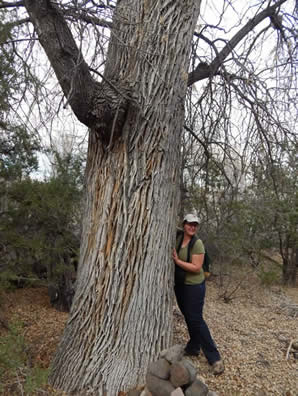 |
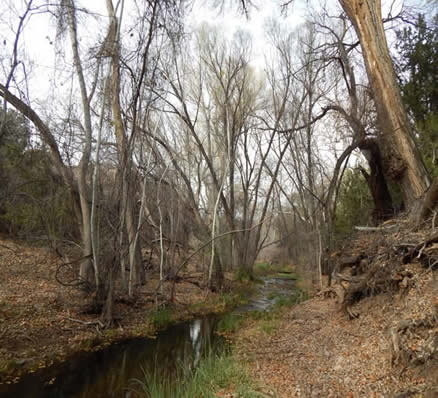 |
|
Figure 7. a) Anne Pellegrini posing next to a huge velvet ash in Bass Canyon and (© Eric Hough)
|
b) riparian area along Double R Canyon (© Eric Hough). |
That night back at our base camp, Anne, Craig, and I were treated to the rare experience of hearing the high-pitched, shrill “howl” of a grasshopper mouse (Onychomys sp.) as it scrabbled around in the leaf litter hunting for prey. Later on after retiring to our tents for the night, I heard the bouncing ball song of a Western Screech-Owl calling as it moved down the wash.
SUNDAY, FEBRUARY 15, 2015
Before dawn we heard the hooting of either a family group or two separate pairs of Great Horned Owls near our base camp. After breaking camp, Craig, Anne, and I made one more visit to the Muleshoe Ranch Preserve headquarters to scan through the frugivore flocks to see if anything more unusual was hanging out with them. We again saw the large flocks of Cedar Waxwings and American Robins gorging on the hackberry fruit, along with a few Hermit Thrushes. The Northern Beardless-Tyrannulet eventually made itself known with its abbreviated, harsh, whistled “BEEup” calls.
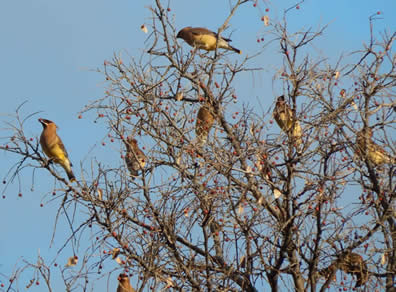 |
Figure 8. Cedar Waxwings feeding on hackberry fruit at Muleshoe Ranch Preserve HQ (© Eric Hough). |
On our way out from the preserve, we stopped to bird some of the grassland patches along the road, including a nice swale among the hills filled with a remnant patch of the tall native grasses that used to cover the region. Here we flushed a couple of very skulky sparrows that never allowed good looks, plus more Vesper and Black-throated Sparrows. Farther south at a stock tank on the west side of the road, we got out to see if any longspur flocks were visiting the tank. After scanning through some mixed sparrow flocks, we eventually heard and saw flocks of Chestnut-collared Longspurs ranging in size from a few individuals to over 80 individuals. As with longspur viewing, our views were frustratingly brief as the flighty birds barely landed to drink before taking off again. However, in some of our views of the larger flocks there appeared to be some McCown’s Longspurs mixed in. While we waited at the edge of the tank for the longspur flocks, we also heard the melodious songs of a couple of ‘Lilian’s’ Eastern Meadowlarks.
As we made our way closer to Willcox, we spotted a Prairie Falcon perched atop one of the powerline poles. Post-expedition birding that Anne and I did around Willcox and Duncan also yielded large aggregations of Sandhill Cranes and Lark Buntings, capping off a great weekend of winter birding.
 |
Figure 9. Tank along Muleshoe Ranch Rd. south of the preserve. |
I would like to thank Craig Anderson, Bob Evans, Sue Kozacek, Anne Pellegrini, Jean Siesener, and Bonnie Swarbrick for helping to make this an excellent expedition and the Muleshoe Ranch Preserve manager, Ron Day, for providing information and allowing us access for surveys.
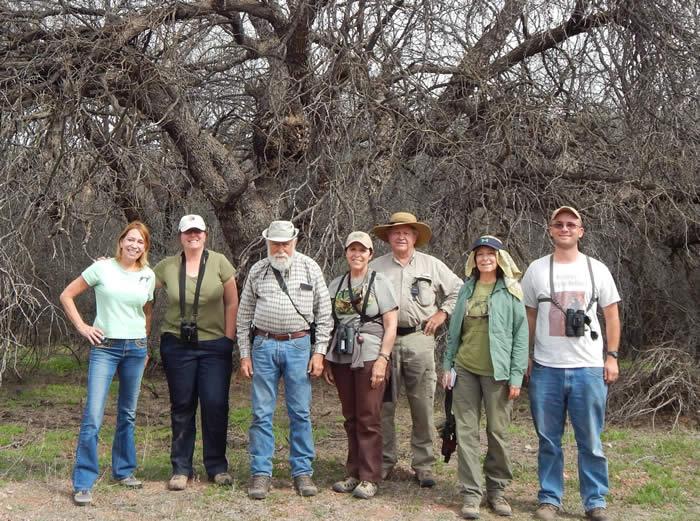 |
Figure 10. AZFO expedition participants (left to right): Bonnie Swarbrick, Anne Pellegrini, Bob Evans, Jean Siesener, Craig Anderson, Sue Kozacek, and Eric Hough (© Eric Hough). |
APPENDIX
Table 1. Species totals for Muleshoe Ranch Preserve and adjacent lands.
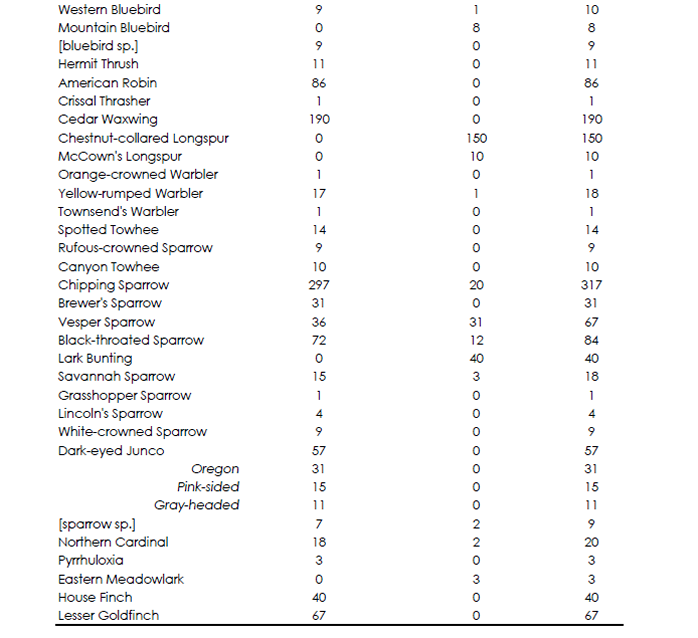 |
|
©2010 |
HOME | | | REPORT SIGHTINGS | | | PHOTOS | | | BIRDING | | | JOURNAL | | | ABOUT US | | | CHECKLISTS | | | AZ BIRD COMMITTEE | | | EVENTS | | | LINKS |